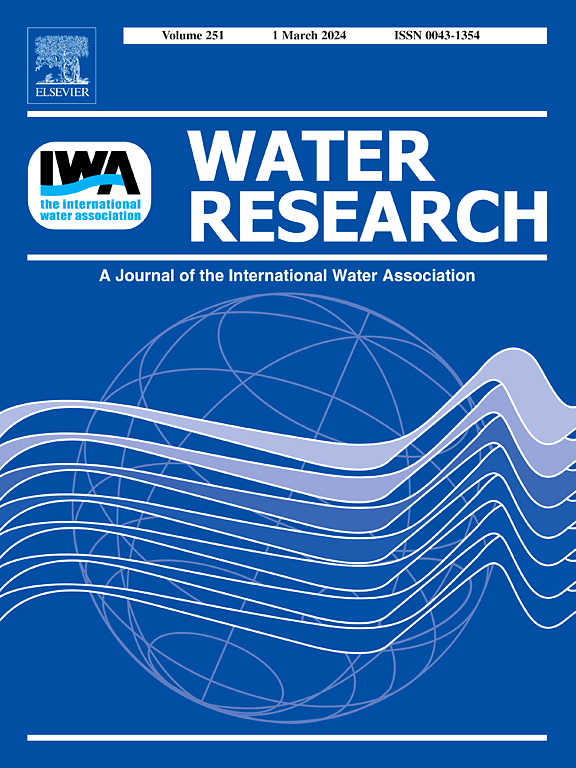Typical migration patterns and fates of microplastics with varying properties in bays and their impacts on coastal ecologically sensitive areas
IF 11.4
1区 环境科学与生态学
Q1 ENGINEERING, ENVIRONMENTAL
引用次数: 0
Abstract
Rapid urbanization has intensified microplastic pollution in many global bays, yet the mechanisms driving microplastic behavior in these environments remain unclear. This study utilized field surveys, statistical analysis, and modeling methods to address this issue. The findings revealed three typical migration patterns of microplastics in bays. Microplastics less dense than seawater were easily transported by currents, drifting extensively throughout the bay, with about 37.2 % temporarily hovering in tidal channels and low-lying areas, ultimately leaving with ebb tides. Spherical microplastics denser than seawater were predominantly concentrated near the shore, primarily lingering in the subsurface layers. In contrast, fibrous microplastics, which are denser than seawater and the most prevalent type in human-impacted bays, displayed a unique behavior. The combined effects of their density and shape resulted in over 80 % being trapped in intertidal ecologically sensitive areas (ESAs). As a result, local ESAs, such as mangroves, bird habitats, and aquaculture, faced significant threats from fibrous microplastics and their sorption complexes associated with Cu, Pb, Cd, and Hg. Additionally, bay sediments acted as a source-sink community for microplastics. In Shenzhen Bay, China, approximately 27.1 × 1011 microplastic items were buried annually in sediments under normal hydrological conditions. However, if annual rainfall exceeded a threshold, these microplastics could be washed into ocean, serving as a source. Coastal raft aquaculture emerged as a significant contributor to marine microplastics, releasing about 3 %-8 % of terrestrial sources in Shenzhen Bay. This study enhances our understanding of microplastic behaviors and risks in bays.


不同性质微塑料在海湾的典型迁移模式和命运及其对沿海生态敏感区的影响
快速城市化加剧了全球许多海湾的微塑料污染,但在这些环境中驱动微塑料行为的机制尚不清楚。本研究利用实地调查、统计分析和建模方法来解决这一问题。研究结果揭示了微塑料在海湾中的三种典型迁移模式。比海水密度小的微塑料很容易被水流运输,在整个海湾广泛漂浮,约37.2%的微塑料暂时徘徊在潮汐通道和低洼地区,最终随着退潮离开。比海水密度大的球形微塑料主要集中在海岸附近,主要停留在次表层。相比之下,纤维微塑料比海水密度大,在人类影响的海湾中最普遍,表现出独特的行为。它们的密度和形状的综合影响导致超过80%的被困在潮间带生态敏感区(esa)。因此,当地的esa,如红树林、鸟类栖息地和水产养殖,面临着纤维性微塑料及其与Cu、Pb、Cd和Hg相关的吸附配合物的重大威胁。此外,海湾沉积物是微塑料的源汇群落。在中国深圳湾,在正常水文条件下,沉积物中每年约埋有27.1 × 1011个微塑料。然而,如果年降雨量超过一个阈值,这些微塑料就会被冲进海洋,成为污染源。沿海木筏养殖成为海洋微塑料的重要来源,释放了深圳湾约3%-8%的陆地微塑料。这项研究增强了我们对海湾中微塑料行为和风险的理解。
本文章由计算机程序翻译,如有差异,请以英文原文为准。
求助全文
约1分钟内获得全文
求助全文
来源期刊

Water Research
环境科学-工程:环境
CiteScore
20.80
自引率
9.40%
发文量
1307
审稿时长
38 days
期刊介绍:
Water Research, along with its open access companion journal Water Research X, serves as a platform for publishing original research papers covering various aspects of the science and technology related to the anthropogenic water cycle, water quality, and its management worldwide. The audience targeted by the journal comprises biologists, chemical engineers, chemists, civil engineers, environmental engineers, limnologists, and microbiologists. The scope of the journal include:
•Treatment processes for water and wastewaters (municipal, agricultural, industrial, and on-site treatment), including resource recovery and residuals management;
•Urban hydrology including sewer systems, stormwater management, and green infrastructure;
•Drinking water treatment and distribution;
•Potable and non-potable water reuse;
•Sanitation, public health, and risk assessment;
•Anaerobic digestion, solid and hazardous waste management, including source characterization and the effects and control of leachates and gaseous emissions;
•Contaminants (chemical, microbial, anthropogenic particles such as nanoparticles or microplastics) and related water quality sensing, monitoring, fate, and assessment;
•Anthropogenic impacts on inland, tidal, coastal and urban waters, focusing on surface and ground waters, and point and non-point sources of pollution;
•Environmental restoration, linked to surface water, groundwater and groundwater remediation;
•Analysis of the interfaces between sediments and water, and between water and atmosphere, focusing specifically on anthropogenic impacts;
•Mathematical modelling, systems analysis, machine learning, and beneficial use of big data related to the anthropogenic water cycle;
•Socio-economic, policy, and regulations studies.
 求助内容:
求助内容: 应助结果提醒方式:
应助结果提醒方式:


